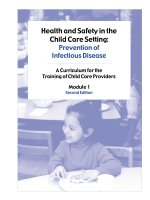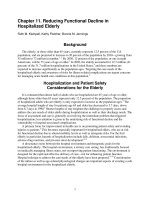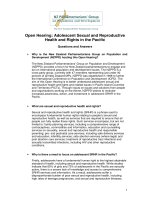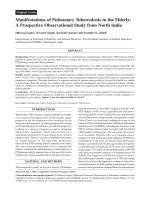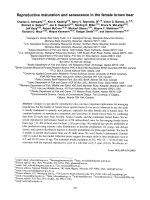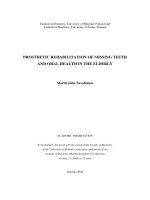Weight loss and malnutrition in the elderly pptx
Bạn đang xem bản rút gọn của tài liệu. Xem và tải ngay bản đầy đủ của tài liệu tại đây (194.5 KB, 4 trang )
CLINICAL PRACTICE
Malnutrition is broadly defined as a nutritional deficit
(undernutrition), excess (overnutrition) or imbalance.
1,2
Malnutrition and unintentional weight loss are issues
frequently underestimated in older people that can be limited,
managed and controlled by timely nutrition intervention.
Malnutrition and unintentional weight loss impact mortality,
morbidity, length of stay and re-admission to hospital,
3
with nutrition
support reducing readmission by more than 29%.
4,5
Malnutrition is
closely linked with recurrent falls and fractures, lost independence
requiring support and care, poor wound healing, and an increase in
complications including infections, pressure sores and skin ulcers.
1
Clinical features of protein energy malnutrition include reduced
body weight, muscle wastage and decreased strength, reduced
respiratory and cardiac muscular ability, skin thinning, decreased
metabolic rate, hypothermia, apathy, oedema and immunodeficiency.
6
Muscle loss in the elderly may reflect sarcopenia, wasting
or cachexia.
7,8
Sarcopenia is a progressive component of aging
exacerbated by limited physical activity, resulting in decreased
functionality and increased frailty.
8,9
Wasting is primarily a result
of inadequate dietary intake, while cachexia is characterised by
catabolism, an increased metabolic rate and protein degradation.
8
Calcium, vitamin D, vitamin B12 and folate are micronutrients
frequently underconsumed in older people. These deficiencies induce
a decreased immune response that could negatively impact on quality
of life and health status.
10
In the absence of adequate dietary calcium, vitamin D will mobilise
skeletal stores of calcium and phosphorous to ensure serum levels are
maintained, at the expense of bone health.
11
However, a deficiency
in vitamin D will also reduce the absorption of dietary calcium,
placing bones at further risk of fractures.
11
Vitamin D and calcium
supplementation can significantly reduce fractures and increase bone
mass density for the elderly.
12,13
This article forms part of a series looking at the relationship
between diet and good health, and the role of the dietician in
the primary health care team. This review highlights some of the
physical, social and medical factors that can indicate compromised
nutritional status in the elderly, the screening tools available to
detect malnutrition, and when to involve a dietician.
Weight loss and malnutrition
in the elderly
The shared role of GPs and APDs
Gemma Sampson
BNutrDiet(Hons), is a clinical dietician, Aged Care
and Rehab, Balmain Hospital, New South Wales.
Reprinted from AUSTRALIAN FAMILY PHYSICIAN
Vol. 38, No. 7, July 2009
507
Weight loss and malnutrition in the elderly – the shared role of GPs and APDsCLINICAL PRACTICE
Physical factors and malnutrition
Weight loss can result from physical factors such as dysphagia,
poor dentition, anorexia, altered taste and smell, and constipation
(Table 1). Poor chewing and swallowing ability can significantly
impact the type and amount of food consumed. Texture modified
diets rarely have the same nutritional quality of a full diet, which can
send dysphagic patients on a continuous downward spiral leading to
protein energy malnutrition.
15
Social factors and malnutrition
Poor appetite, inappropriate food choices, food aversion, decreased
energy and inability to self feed can result from social factors and can
place individuals at risk of malnutrition.
Malnutrition is more common for institutionalised elderly than
independently living elderly – with more than 50% of people living in
hospitals or nursing homes affected.
15
Obtaining adequate vitamin D
can be a challenge for institutionalised and house bound older people
who have limited sun exposure.
Living or eating alone causes older people to eat less and
increases their risk of compromised nutritional status, with men
being particularly vulnerable. Many older people living alone
exist on a ‘tea and toast’ diet that is low in energy, protein
and micronutrients. Taste changes often result in a dislike
and avoidance of nutrient dense foods (eg. lean meat). These
factors place the individual at a higher risk of malnutrition and
micronutrient deficiencies.
15
Restrictive diets due to personal preference, cultural or religious
beliefs, or for medical purposes (including low cholesterol, low salt,
vegetarian, kosher and halal diets) can increase the risk of protein
malnutrition and micronutrient deficiency as they remove or limit
common high protein foods.
Medical conditions and malnutrition
Chronic illness has the ability to alter and limit the type and amount of
food consumed (due to pain, anorexia, nausea, fatigue and shortness
of breath) and may benefit from nutritional intervention.
3
Polypharmacy plays a large role in unintentional weight loss.
More than 250 drugs impact the intake, absorption, metabolism
and excretion of nutrients.
15
Table 2 summarises the susceptibility
of malnutrition from some commonly prescribed medications.
Table 3 provides specific examples of drug nutrient interactions of
some common medications.
Constipation is another common complaint in elderly patients
resulting from a combination of polypharmacy, low fibre diets and
limited fluids.
Cognitive decline and self neglect of isolated older people
increases susceptibility to malnutrition and deficiencies in folate,
antioxidants and vitamin D.
16
The relationship between malnutrition
and cognitive function is complex, with malnutrition likely to be a
cause and consequence of cognitive decline.
16
Malnutrition may
Vitamin B12 and folate are essential to prevent anaemia,
neuropathic degeneration of nerve fibres and irreversible neurological
damage such as burning and tingling of the hands and feet
(parasthesia), dementia, glossitis and chelosis. Low vitamin B12 is
also an independent risk factor in developing venous thromboembolic
disease in men over the age of 70 years.
14
Table 1. Risk factors for malnutrition
Physical
Anorexia
Lost taste and smell
Poor dentition
Dysphagia
Texture modified diets and thickened fluids
Early satiety
Physical impairment restricting activities of daily living (ADL) and
ability to self feed
Unintentional weight loss
Muscle wastage
Social
Financial restraints, poverty
Limited knowledge and skills in food, nutrition and cooking
Living alone, social isolation, loneliness
Reduced mobility and lack of transport
Lack of assistance with ADL
Restrictive diets (eg. vegetarian, halal, kosher, low fat)
Excessive alcohol intake
Medical
Polypharmacy
Drug nutrient interactions and adverse effects
Infections
Fractures
Wounds and pressure sores
Dementia
Depression
Table 2. Side effect of medications that impact on nutrition
24
Nausea/vomiting Antibiotics, opiates, digoxin, theophylline,
nonsteroidal anti-inflammatory agents (NSAIDs)
Anorexia Antibiotics, digoxin
Decreased sense of
taste
Metronidazole, calcium channel blockers, angiotensin
converting enzyme inhibitors (ACEIs), metformin
Early satiety Anticholinergic drugs, sympathomimetic agents
Reduced feeding ability Sedatives, opiates, psychotropic agents
Dysphagia Potassium supplements, NSAIDs, biphosphonates,
prednisolone
Constipation Opiates, iron supplements, diuretics
Diarrhoea Laxatives, antibiotics
Hypermetabolism Thyroxine, ephedrine
508
Reprinted from AUSTRALIAN FAMILY PHYSICIAN
Vol. 38, No. 7, July 2009
Weight loss and malnutrition in the elderly – the shared role of GPs and APDs CLINICAL PRACTICE
Enhanced Primary Care (EPC) program. Referrals must be made using
the EPC program referral form for individual allied health services
under Medicare.
22
Frail elderly patients over 65 years of age may be eligible for dietetic
services through home and community care.
23
Home and community
care APDs support the frail elderly to maintain their independence
in the community, enhance quality of life, and prevent premature or
inappropriate admission to long term residential care.
24
Summary
General practitioners can help prevent and manage malnutrition in
elderly patients by:
•weighingelderlypatientsateveryappointment
cause cognitive deterioration which may influence eating behaviours,
resulting in further deficiencies and cognitive issues.
Early identification of depression is important in screening
for possible malnutrition. An independent relationship between
nutritional deficiencies and depression exists with depression being
the greatest factor triggering unintentional weight loss in elderly
people.
17
Elderly with chronic medical illnesses and cognitive
decline are most susceptible, with bereavement, polypharmacy,
disability and social isolation also increasing the likelihood of
depression in this group.
Screening for malnutrition
As often the first point of contact of patient care in the community,
general practitioners have the opportunity to identify and assess risk
factors leading to compromised nutritional status in elderly patients.
No one standard test or biochemical marker is used to indicate or
diagnose malnutrition in the elderly. A combination of medical, social,
anthropometric, biochemical, clinical and dietary data are required
to thoroughly assess, monitor, evaluate and determine appropriate
nutritional therapy.
2
The Subjective Global Assessment (SGA) tool is the ‘gold standard’
for assessing malnutrition in hospitalised elderly due to its simplicity,
accuracy and reliability.
18
The Mini Nutritional Assessment Short
Form (MNA-SF) is well validated for early detection of malnutrition in
community dwelling elderly people.
19
Weight alone is inadequate in measuring nutritional status in older
people as a stable weight may mask changes in body composition.
9
Adipose tissue replaces muscle mass in normal aging (Figure 1)
9
with
greater rates being likely in a sick, elderly population.
2
A body mass index (BMI) range of 22–27 kg/m
2
can be used to
determine a healthy weight range in older people. Although age
related changes in body composition can make BMI an unreliable
indicator of malnutrition,
7
a BMI <20 kg/m
2
is a reasonable threshold
to define a high risk of malnutrition.
7
The Royal Australian College of General Practitioners publication
Guidelines for preventive activities in general practice (the ‘red book’)
is a useful tool for highlighting possible malnutrition (see Resources).
Extended primary care services such as the Medicare Health
Assessment for Older Persons for patients over 75 years and
Aboriginal and Torres Strait Islanders over 55 years provide the
opportunity to assess nutritional status
20,21
and can provide Medicare
subsidised access for eligible patients to an Accredited Practising
Dietitian (APD) via a team care arrangement.
Accessing APD services
An APD can assess patients, educate and advise on the best dietary
approach, liaise with carers and help organise nutritional supplements
(as necessary) to manage and prevent unintentional weight loss and
malnutrition in elderly patients (see Resources).
General practitioners can refer eligible patients to an APD
(item 10954) for a maximum of five allied health services using the
Table 3. Specific drug nutrient interactions of common medications
25
Nutrients impacted Clinical symptoms
Metformin Vitamin B12
Folate
Nausea and vomiting
Constipation and diarrhoea
Weight loss
Loss of appetite
Altered taste
Pantoprazole Calcium
Iron
Osteoporosis
Nausea and vomiting
Constipation and diarrhoea
Digoxin Potassium
Magnesium
Calcium
Thiamine
Nausea and vomiting
Diarrhoea
Weight loss
Loss of appetite
Phenytoin Folate
Potassium
Magnesium
Calcium
Vitamin B12
Biotin
Vitamin K
Vitamin D
Nausea and vomiting
Constipation
Weight gain
Loss of appetite
Altered taste
Age (years)
Percentage
Body fat (kg)
Muscle (kg)
30
25
20
15
10
5
0
20–29 40–49 60–69 70–79
Figure 1. Body composition changes in healthy adult males
Reprinted from AUSTRALIAN FAMILY PHYSICIAN
Vol. 38, No. 7, July 2009
509
Weight loss and malnutrition in the elderly – the shared role of GPs and APDsCLINICAL PRACTICE
16. Smith SM, Oliver SA, Zwart SR, et al. Nutritional status is altered in the self-
neglecting elderly. J Nutr 2006;136:2534–41.
17. Cabrera M, Mesas A, Garcia A, de Andrade S. Malnutrition and depression among
community-dwelling elderly people. J Am Med Dir Assoc 2007;8:582–4.
18. Wakahara T, Shiraki M, Murase K, et al. Nutritional screening with Subjective
Global Assessment predicts hospital stays in digestive diseases. Nutrition
2007;23:634–9.
19. Guigoz Y, Lauque S, Vellas BJ. Identifying the elderly at risk for malnutrition. The
Mini Nutritional Assessment. Clin Geriatr 2002;18:737–57.
20. Australian Government. Department of Health and Ageing. Older persons health
assessment fact sheet. Items 700 to 706. 2008. Available at www.health.gov.au/
internet/main/publishing.nsf/Content/health-epc-hlthassmnt-factsheet
21. Australian Government. Department of Health and Ageing. Medicare Health
Assessment for Older Person’s (Items 700 and 702). 2008. Available at www.
health.gov.au/internet/main/publishing.nsf/Content/9863A14D80061159CA256F1
9001D05C4/$File/Older%20Person%20Proforma%20final.pdf.
22. EPC Program Referral form for individual allied health services under Medicare.
Available at www.health.gov.au/internet/main/publishing.nsf/Content/D1034B46
BB0ABF59CA256F19003CB524/$File/EPCAHS%200109.pdf.
23. Department of Ageing, Disability and Home Care. 2008. Standard service
type description – allied health dietetics 10.08. Available at www.dadhc.nsw.
gov.au/NR/rdonlyres/179CB674-C327-4F49-BA8C-B212916E2436/3586/10_08_
AlliedHealth_Dietetics.pdf.
24. Visvanathan R, Newbury JW, Chapman I. Malnutrition in older people. Screening
and management strategies. Aust Fam Physician 2004;33:799–805.
25. Coleman Y. Drug-nutrient interactions. The handbook. Hawthorn, Australia:
Nutrition Consultants Australia, 2003.
•notingthataBMI<20kg/m
2
is likely to indicate underweight in
the elderly
•checkingforpossiblemusclewastage,fatgainoroedema–evenif
weight is constant
•beingcognisantthatobesitymaymaskpoornutrition
•annually completingthe Medicare HealthAssessment for Older
Persons >75 years to screen for nutrition risks
•using theRACGP ‘red book’to screen for depression, dementia,
falls history, polypharmacy and caregivers health
•undertaking tests where appropriate for vitamin B12, folate,
calcium, vitamin D and blood glucose
•notingnutritionaldeficienciescausedbymedications
•referring earlytoappropriate allied healthprofessionalsincluding
APDs, dentists, speech pathologists, occupational therapists and
physiotherapists.
Resources
• TheRoyalAustralianCollegeofGeneralPractitioners.2009.Guidelinesfor
preventive activities in general practice. 7th edn. Available at www.racgp.
org.au/guidelines/redbook
• Tofind anAPDinyour localarea,visit the‘Findan APD’sectionofthe
Dietitians Association of Australia website at www.daa.asn.au or tel-
ephone 1800 812 942.
Conflict of interest: none declared.
References
1. Gary R. Nutritional status: Key to preventing functional decline in hospitalized
older adults. Top Geriatr Rehabil 2002;17:40–71.
2. Hickson M. Malnutrition and ageing. Postgrad Med J 2006;82:2–8.
3. Ackner G, Cederholm T. Treatment of protein-energy malnutrition in chronic non-
malignant disorders. Am J Clin Nutr 2001;74:6–24.
4. Hebuterne X, Bermon S, Schneider SM. Ageing and muscle: the effects of mal-
nutrition, re-nutrition, and physical exercise. Curr Opin Clin Nutr Metabol Care
2001;4:295–300.
5. Gariballa S, Forster S, Walters S, Powers H. A randomized, double-blind, placebo-
controlled trial of nutritional supplementation during acute illness. Am J Med
2006;119:693–9.
6. Hoffer LJ. Clinical nutrition: 1. Protein-energy malnutrition in the inpatient. CMAJ
2001;165:1345–9.
7. Seidell J, Visscher T. Body weight and weight change and their health implica-
tions for the elderly. Eur J Clin Nutr 2000;54:S33–9.
8. Roubenoff R. Sarcopenia and its implications for the elderly. Eur J Clin Nutr
2000;54:S40–7.
9. Gallagher D, Ruts E, Visser M, et al. Weight stability masks sarcopenia in elderly
men and women. Am J Physiol Endocrinol Metab 2000;279:E366–75.
10. Lesourd B. Nutrition and immunity in the elderly: Modification of immune
responses with nutritional treatments. Am J Clin Nutr 1997;66:478S–84.
11. Holick M. Vitamin D deficiency in obesity and health consequences. Curr Opin
Endocrinol Diabetes 2006;13:412–8.
12. Harwood RH, Sahota O, Gaynor K, Masud T, Hosking DJ. A randomised, control-
led comparison of different calcium and vitamin D supplementation regimens in
elderly women after hip fracture: The Nottington Neck of Femur (NONOF) Study.
Age Ageing 2004;33:45–51.
13. Trivedi D, Doll R, Khaw K. Effect of four monthly oral vitamin D3 (cholecalciferol)
supplementation on fractures and mortality in men and women living in the com-
munity: randomised double blind controlled trial. BMJ 2003;326:469.
14. de Tuesta D, Belinchon R, Marchena P, et al. Low levels of vitamin B12 and venous
thromboembolic disease in elderly men. J Intern Med 2005;258:244–9.
15. Brownie S. Why are elderly individuals at risk of nutritional deficiency? Int J Nurs
Pract 2006;12:110–8.
CORRESPONDENCE
510
Reprinted from AUSTRALIAN FAMILY PHYSICIAN
Vol. 38, No. 7, July 2009
